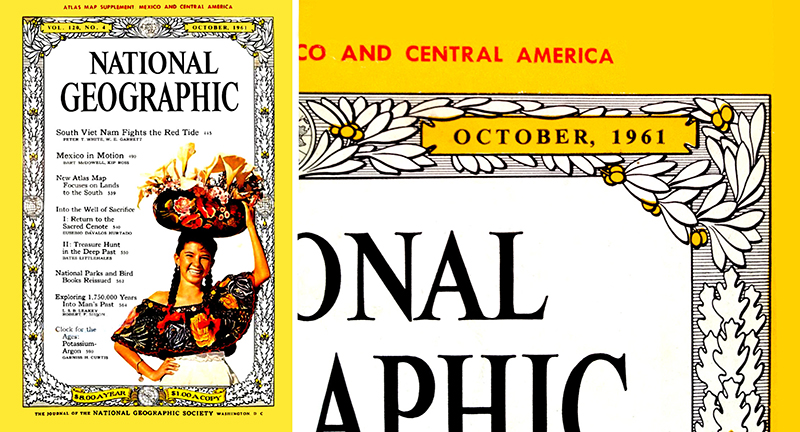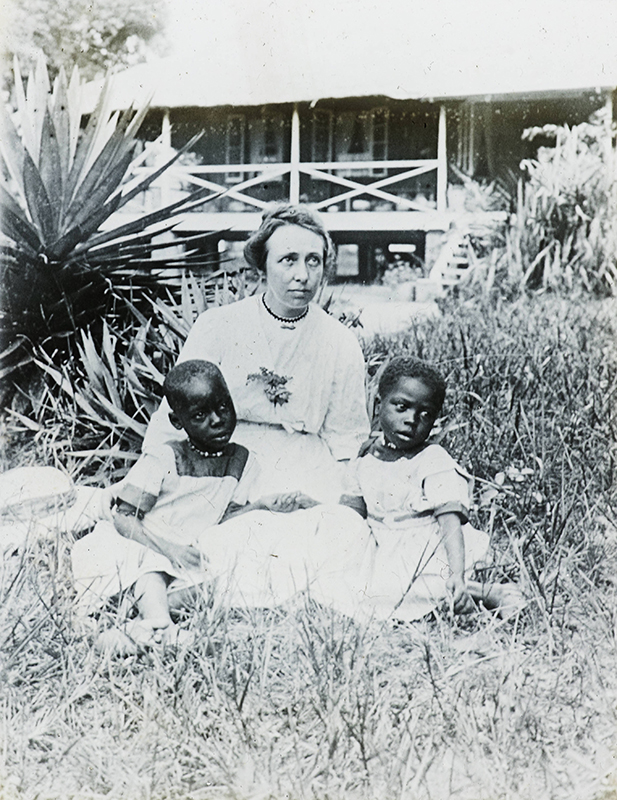15.5: Photography, Representation, and Memory
- Page ID
- 150318
By the end of this section, you will be able to:
In addition to creating their own visual media, visual anthropologists conduct research on how the people they study produce visual media to represent themselves as well as cultural others.
Have you ever browsed through a copy of the magazine National Geographic? In the latter half of the 20th century, many American schools and middle-class households subscribed to this magazine as an educational resource for school-age children. Founded in 1888, the magazine has developed a reputation for its colorfully illustrated coverage of science, geography, history, and world cultures. Now owned in part by the Walt Disney Company, the magazine is published in 40 languages and has a global circulation of over six million.
What strikes many young people about National Geographic is not so much the informative textual content but rather the alluring images of non-Western peoples. Cultural anthropologist Catherine Lutz and sociologist Jane Collins (1993) set out to study how National Geographic depicted people in contexts outside the United States and western Europe. In their holistic approach, they conducted research into the production process at National Geographic, then subjected the photographs to rigorous content analysis, and finally interviewed people about how they made sense of the images.

Based on analysis of 600 National Geographic photos depicting non-Western peoples from 1950 to 1986, Lutz and Collins noted that the magazine portrayed non-Western peoples as exotic, idealized, and close to nature. Very rarely did photographs in the magazine reveal any traces of the complex colonial and postcolonial histories of their subjects or their entanglements in national and global processes. Instead, National Geographic photographs tended to depict happy people immersed in purely traditional lifeways. Without historical or political context, the apparent difference between “us” (the viewer) and “them” (the people depicted in the photographs) would seem to be developmental or evolutionary. In other words, the people depicted in the images were made to seem simpler or more backward than those viewing the images. Perhaps, the images seem to suggest, “they” have not yet achieved modernity. While emphasizing a theme of common humanity, the magazine nonetheless reproduced primitivist and orientalist stereotypes about non-Western peoples while obscuring the historical and political processes that have shaped their equally complex lifeways.
The Gaze of Photography
In the 1970s, film scholars developed the concept of the gaze to refer both to specific ways that viewers look at images of other people in visual media and to the gazes of those depicted within the images. Gaze theory attempts to understand what it means to view people and events through mass media.
Two key features of the gaze are important to this goal. First, the object being gazed at (the person or people in the image) is not aware of the viewer. This makes the gaze voyeuristic, like an anonymous peeping Tom looking through a window into a house. The gazer knows what is going, on but the people in the house (or the image) do not know they’re being watched. Second, and because of the first point, the gaze implies a psychological relationship of power; the watching person has the power to scrutinize, analyze, and judge the watched people. The watcher can manipulate the perspective and conditions of watching. The watcher reserves the power to make sense of the image and to use the image however they please—for knowledge, pleasure, or criticism.
British film theorist Laura Mulvey (1975) used the concept of the gaze to develop a feminist approach to film studies. The male gaze describes how men look at women through any visual medium and even in everyday life. Beauty culture in western Europe and the United States positions women as objects to be gazed upon by men (and other women). Media scholars argue that women come to view themselves through the gaze of others, particularly men, who evaluate the attractiveness and desirability of their bodies. Thus, rather than experiencing her selfhood directly, a woman’s self-image is routed through the male gaze.
The concept of the gaze is also used to think about other sociocultural power relations, particularly the historical processes of imperialism and colonialism. In the colonial period, the desire for conquest motivated strategic ways of gazing at cultural others. Through forms of media and image making developed in the 19th and early 20th centuries, Europeans developed an imperial gaze, positioning themselves as viewers of non-Western peoples. In the visual practices of empire, such as surveys and documentary photography, the lands and peoples were scrutinized, subjected to the domineering eye of European colonizers. The depictions of non-Western peoples in National Geographic are current manifestations of the imperial gaze.
Photography and the Colonial Gaze
Photography was invented in the early 19th century and became widespread in the period when European countries were beginning to establish formal colonial rule over African, Middle Eastern, and Asian territories. In colonial contexts, the imperial gaze framed how Europeans photographed colonial landscapes and colonized peoples, positioning them in strategic ways to justify colonial rule.
As the head of the Basel Mission Society’s large archive of colonial photographs, historian Paul Jenkins (1993) has studied pictures taken by Swiss and German missionaries in Africa. The Basel Mission Society (BMS) was a Christian missionary group that participated in the larger trend of Christian missionizing in Africa in the late 19th and early 20th centuries. Jenkins’s inquiry sought to understand what the BMS photos reveal about the people in the photographs, the people who took the photos, and the wider conditions in which the photos were taken.
Jenkins’s analysis focuses on one particular missionary, Christian Hornberger, who worked in southeastern Ghana in the late 19th century. In 1863, the BMS asked Hornberger to take photographs depicting missionary activities in Ghana to be sold to European Christians who donated to the African missionary effort. Hornberger took many pictures of African children, the mission station, the local landscape, and scenes from Indigenous life. Jenkins points out that the earliest photographs taken by Hornberger emphasize the strangeness of African peoples and environments, while the later ones seem to emphasize the kind of common humanity found in later National Geographic photos. In Hornberger’s later photographs, Africans are depicted in ways that would have been familiar to many Europeans: families are shown eating dinner together, women are depicted grinding corn, and local craftspeople are shown creating pottery.
A set of photographs of children dressed in European clothing caught Jenkins’s eye. Who were these children, and why were there so many photos of them? Where were their parents? Digging deeper, Jenkins discovered that these were local “slave children” (1993, 100) bought into freedom by missionaries and taken to live on the mission compound. In West Africa at the time, people who fell into debt could “pawn” their children to work as servants in lieu of paying the debt. Sometimes, children were given to the priests of local shrines as payment for wrongdoing or gratitude for good fortune. As early Christian missionaries did not initially have much luck converting local peoples to Christianity, some BMS missionaries saw this practice as a way to both accumulate converts and drum up European support. BMS missionaries began offering European supporters the opportunity to “purchase” the freedom of a particular child, give the child a Christian name, and provide for the child’s food, clothing, and other needs. Most of the African children in BMS photos of the time are subjects of this child-sponsorship program.

While this may have seemed like a win-win scheme all around, the “liberation” of African slave children was apparently experienced by the many of the children as a new form of enslavement. Most were unhappy living on the mission compound, divorced from their home cultures, forced to wear uncomfortable clothing and speak a strange language. Many of them ran away, back to the families they had been serving before the missionaries intervened. By 1868, the BMS was forced to abandon the whole scheme. The backstory of Hornberger’s photographs of these children vividly illustrates the strategic artifice of the imperial gaze—how missionaries used photography to position themselves as saviors while local people often saw them as agents of colonial domination. The entire collection of photographs from the Basel Mission Society is archived at the BM Archives website.
The Modernity of Postcolonial Photography
Focusing on more contemporary contexts, many media anthropologists analyze the images produced by postcolonial subjects themselves, along with the producers of those images and the production process. Rather than scrutinizing the imperial or ethnographic gaze, these scholars are interested in local forms of gazing at the self and others in photographs.
Anthropologist Liam Buckley (2000) has conducted research on studio photography in the West African country of Gambia. Through interviews with photographers and their subjects, Buckley traced the development of photographic strategies from the more realist style of the 1950s to the more fanciful and imaginative style common from the 1970s to the early 2000s.
In the 1950s, photographs were valued for faithfully depicting the character, mood, and personality of the subject, what people referred to as jikko. More recently, people began to prefer being photographed against elaborate studio backdrops depicting scenes of modern leisure and cosmopolitan travels. A staging popular with young people in particular features the subject relaxing amid an array of appliances, such as radio, television, and an open refrigerator full of cold beverages and tasty foods. Some backdrops depict subjects climbing the stairs to board an airplane or visiting a foreign tourist destination. Gambians use the term juuntuwaay to describe the props and imported goods included in these scenes, which might include bicycles, pens, and sunglasses. Young people use these objects to “‘complete’ themselves” (Buckley, 2000), thus using the photograph as a form of aspirational identity formation. The goal of this form of portraiture is not to depict personal jikko but rather to represent jamano, a sense of fashionable novelty and change.


